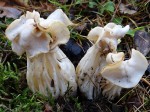 Also known as white saddle, and elfin saddle, this sac fungus (Ascomycetes) may be found growing singly or in troops in deciduous or coniferous woods on calcareous soil in most northern temperate regions including North America from summer to autumn. It is mycorrhizal, often being associated with beech and oak, but can be found along paths, in grassy areas including lawns, and along hedges. The mushroom stands 1 ½ to 4 ½ inches tall and has a very curled, convoluted cream colored cap that resembles a brain. The cap is ¾ to 2 ½ inches across and can also be considered saddle-shaped. It has irregular, sinuous upturned margins that reveal the wrinkled, yellow ochre underside. The spore producing surface is lumpy and cream colored and the spores are white. The stem is white darkening to yellow with age and has ridges and grooves along its surface and hollow chamber insides.
Also known as white saddle, and elfin saddle, this sac fungus (Ascomycetes) may be found growing singly or in troops in deciduous or coniferous woods on calcareous soil in most northern temperate regions including North America from summer to autumn. It is mycorrhizal, often being associated with beech and oak, but can be found along paths, in grassy areas including lawns, and along hedges. The mushroom stands 1 ½ to 4 ½ inches tall and has a very curled, convoluted cream colored cap that resembles a brain. The cap is ¾ to 2 ½ inches across and can also be considered saddle-shaped. It has irregular, sinuous upturned margins that reveal the wrinkled, yellow ochre underside. The spore producing surface is lumpy and cream colored and the spores are white. The stem is white darkening to yellow with age and has ridges and grooves along its surface and hollow chamber insides.
Common brain fungus has been considered edible and has a pleasant flavor that has been likened to morels. It should not be eaten raw under any circumstances because in addition to causing digestive problems it contains hemolysins that destroy red blood cells. Hemolysins are destroyed by heat during cooking but once the fungus is cooked is lacks flavor and becomes leathery. In addition, common brain fungus may also contain carcinogens. If you decide to take a chance with eating this mushroom be sure to seek expert advice on identification.
Photo Credit: By Jerzy Opioła – Own work, CC BY-SA 3.0, Link